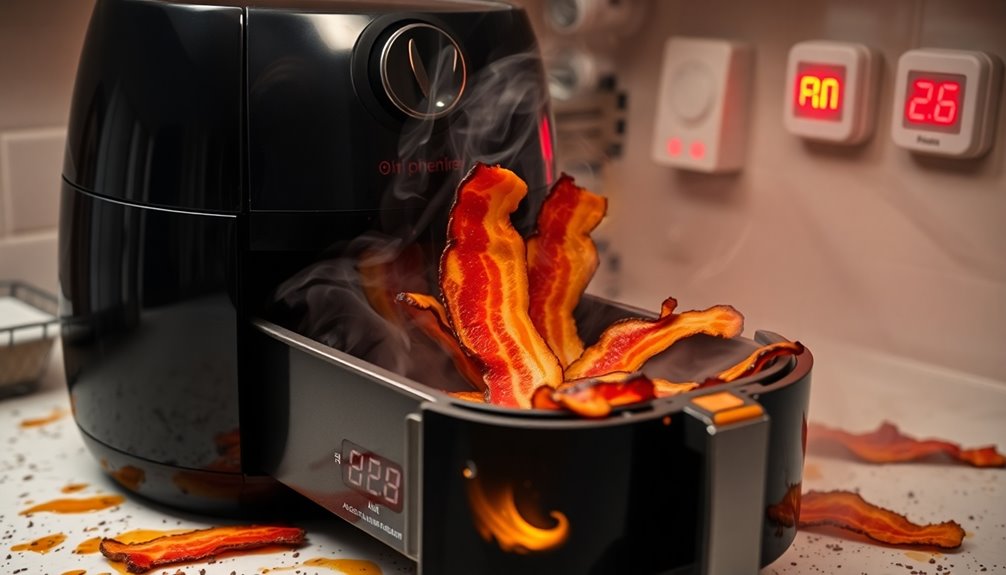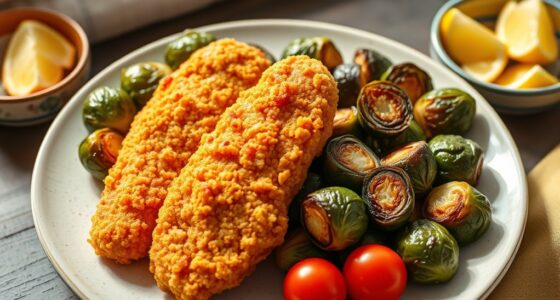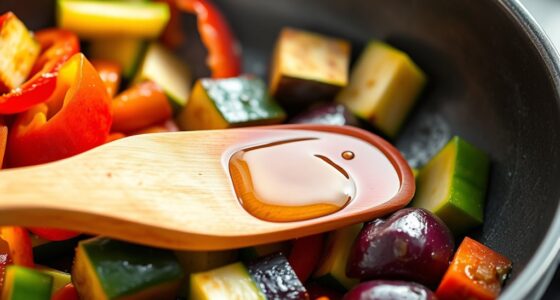You should never cook bacon in your air fryer because it risks uneven cooking, leaving you with both undercooked and overcooked pieces. Undercooked bacon can harbor harmful bacteria, raising your chances of foodborne illness. Plus, the high fat content of bacon can create excessive smoke and even fire hazards. You'll also struggle with grease accumulation, complicating cleanup, while the flavor often falls flat compared to traditional methods. For better texture and taste, consider alternative cooking techniques like skillet frying or oven baking. Stick around to discover even more reasons why air frying bacon might not be the best choice.
Key Takeaways
- Air fryers can lead to uneven cooking of bacon, resulting in both undercooked and overcooked pieces that pose food safety risks.
- Raw bacon may carry harmful bacteria, and undercooked bacon increases the likelihood of foodborne illnesses if not handled properly.
- Excess grease from bacon can accumulate in the air fryer, complicating the cleaning process and potentially damaging the appliance.
- Air-fried bacon often lacks the rich, smoky flavor and desired texture achieved through traditional cooking methods like skillet frying or oven baking.
- High-fat content in bacon can produce excessive smoke, creating fire hazards and unpleasant odors during air frying.
Air Fryer Cooking Mechanics
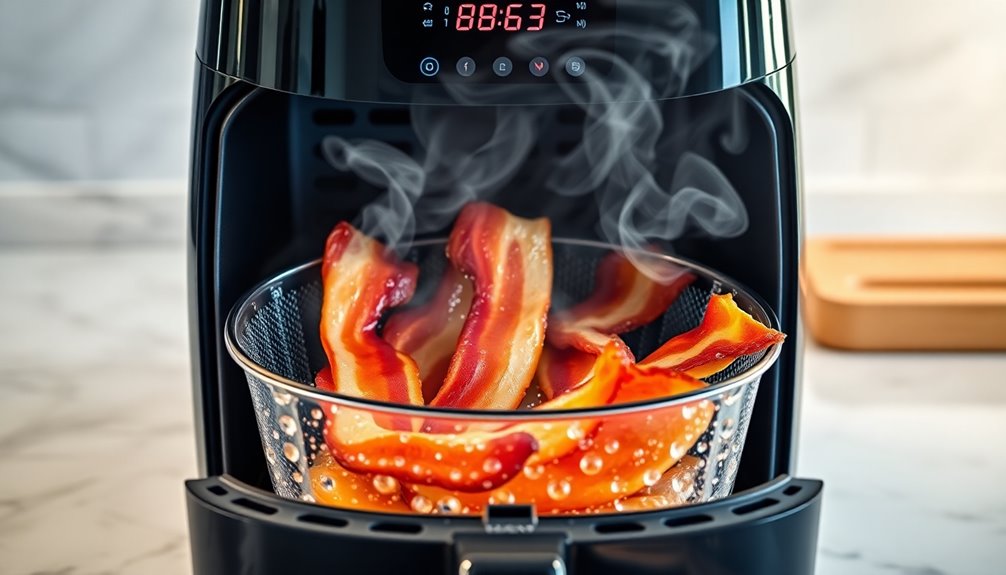
Air fryers are a game-changer in the kitchen, transforming the way you cook your favorite foods.
These innovative appliances use convection heat, rapidly circulating hot air around your ingredients, making them cook evenly without needing additional oils.
Compared to traditional cooking methods, air fryers provide quicker cooking times due to their compact design, allowing high temperatures to reach your food more efficiently.
When cooking bacon, the high temperatures can cause fat to render quickly, which is great for crispiness but can lead to smoke if you're not careful.
Remember, proper air circulation is essential; overcrowding the basket or using foil can hinder airflow, resulting in less-than-ideal cooking outcomes.
Enjoy the benefits of air fryers while keeping these mechanics in mind!
Risks of Cooking Bacon
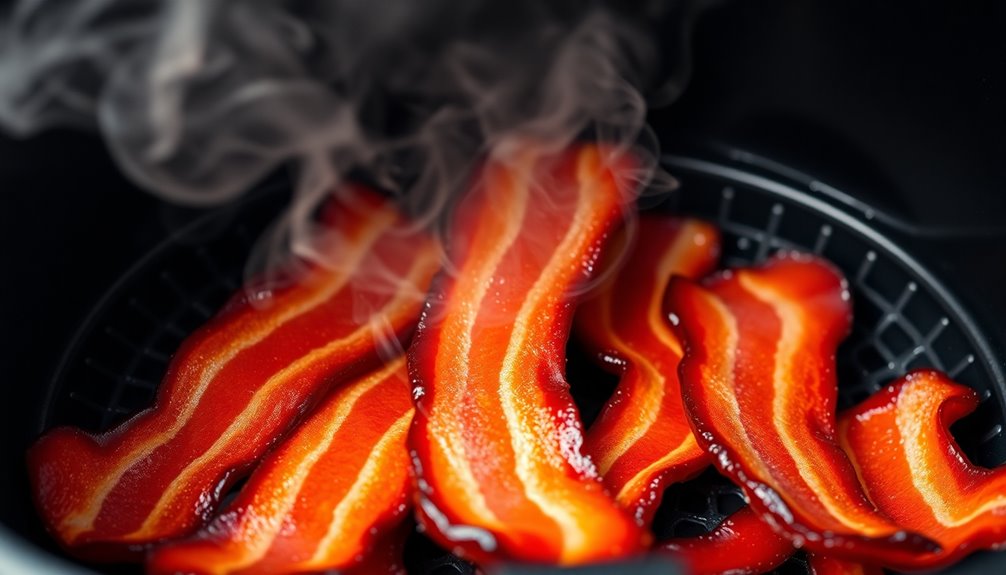
While cooking bacon in an air fryer can seem like a quick and easy option, it comes with several risks that can impact both safety and flavor. The high-fat content of bacon often leads to uneven cooking, causing some pieces to be undercooked and others overcooked. This unevenness can increase the risk of foodborne illnesses, as harmful bacteria may not be eliminated. Additionally, the excessive smoke produced can create fire hazards, while rendered grease requires inconvenient cleaning. Ultimately, the convenience of air frying bacon doesn't outweigh the potential downsides compared to traditional cooking methods.
| Risk | Description |
|---|---|
| Uneven Cooking | Some bacon may be undercooked or overcooked. |
| Foodborne Illnesses | Undercooked bacon can harbor harmful bacteria. |
| Excessive Smoke | High-fat content creates a smoky kitchen. |
| Cleaning Challenges | Grease accumulation leads to risky cleanup. |
| Compromised Flavor | Air-fried bacon lacks the taste of traditional methods. |
Cross-Contamination Issues
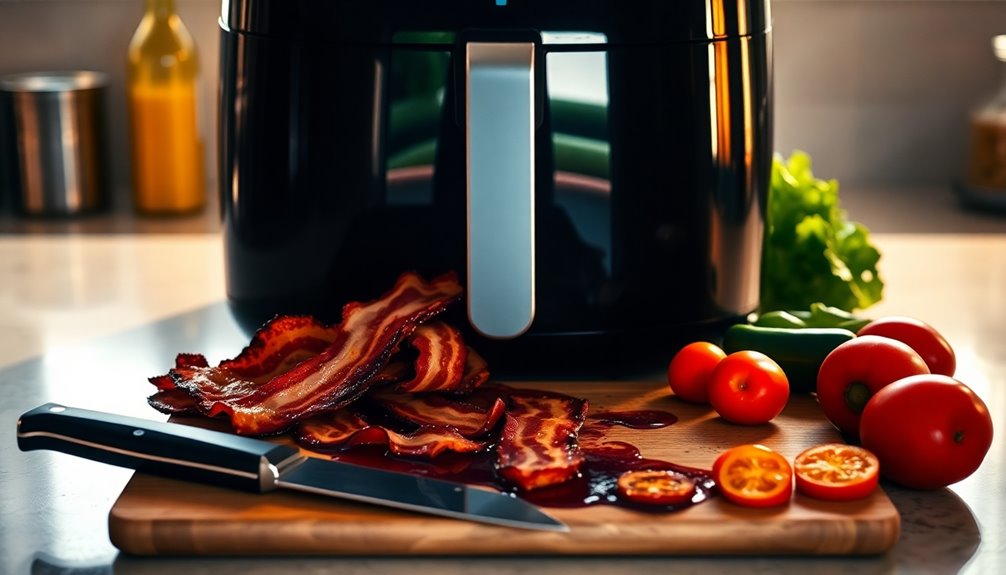
Ensuring food safety is essential when cooking bacon in an air fryer, as raw bacon can harbor harmful bacteria like Salmonella. If you undercook bacon, those bacteria may survive, increasing your risk of foodborne illnesses.
Additionally, the air fryer basket can become contaminated with bacteria from raw bacon, which can affect any subsequent foods cooked in the same appliance. Cross-contamination becomes a real concern if you don't thoroughly clean the air fryer after cooking bacon.
Bacteria can linger in unclean baskets, spreading to other ingredients. To protect yourself and your family, always follow strict food safety practices, including cleaning the air fryer after each use.
It's a simple step that can help prevent cross-contamination and keep your meals safe.
Alternative Cooking Methods
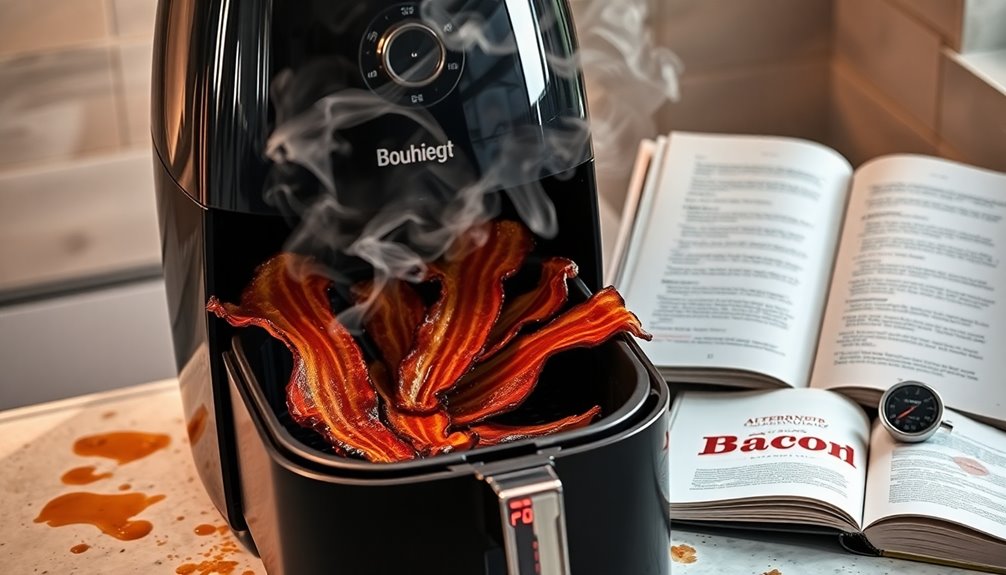
If you're looking for different ways to cook bacon, the oven is a great option for making larger batches evenly.
Skillet cooking gives you more control, so you can flip the bacon to achieve your perfect crispiness.
And if you're short on time, the microwave offers a quick method, though it might leave the bacon a bit chewier than you'd like. Additionally, using the right cooking temperature can help ensure that your bacon turns out crispy and delicious.
Oven Baking Benefits
Oven baking offers several advantages when cooking bacon, especially when you need to prepare large quantities. You can easily cook a whole batch at once, making it efficient for feeding a crowd.
By baking bacon on a foil-lined sheet at 400°F for 15-20 minutes, you achieve consistent crispiness without the splatter and mess that frying can cause. The grease drips away, reducing the risk of smoke and burning, while also enhancing the flavor and texture of your bacon.
Plus, cleanup becomes a breeze since the grease collects on the foil, allowing for simple disposal. You'll appreciate the ease of oven baking, making it a go-to method for delicious bacon every time! Additionally, implementing efficient storage strategies in your kitchen can help maintain an organized cooking space, enhancing your overall culinary experience.
Skillet Cooking Control
When it comes to cooking bacon, skillet methods offer remarkable control over the process. You can enjoy precise temperature control, which lets you adjust the heat to get that perfect bacon texture without burning. Using a cast-iron skillet promotes even cooking, guaranteeing your bacon is crispy, not chewy. You can easily monitor the cooking, allowing for quick flips and adjustments. Plus, the rendered fat can enhance the flavors of other dishes, reducing waste compared to air frying. Additionally, the rendered fat can be used to create delicious sauces or for sautéing vegetables, making the most of your cooking ingredients.
| Skillet Cooking Benefits | Details |
|---|---|
| Precise Temperature | Adjust heat as needed |
| Even Cooking | Guarantees uniform crispiness |
| Rendered Fat Usage | Enhances flavor in other dishes |
| Batch Cooking | Cook more bacon at once |
Quick Microwave Method
Although you might think frying is the only way to achieve crispy bacon, the microwave method offers a quick and convenient alternative. This technique not only saves time but also simplifies cleanup.
Here are some benefits of cooking bacon in the microwave:
- Takes only 3 to 4 minutes
- Reduces bacon grease mess
- Allows for even heat distribution
- Works well for small batches
- Adjusts easily for different thicknesses
While you may get a chewier texture, the flavor remains intact without added oils.
Plus, using microwave-safe plates and paper towels absorbs excess grease, making your cooking experience even easier.
Maintenance and Safety Tips
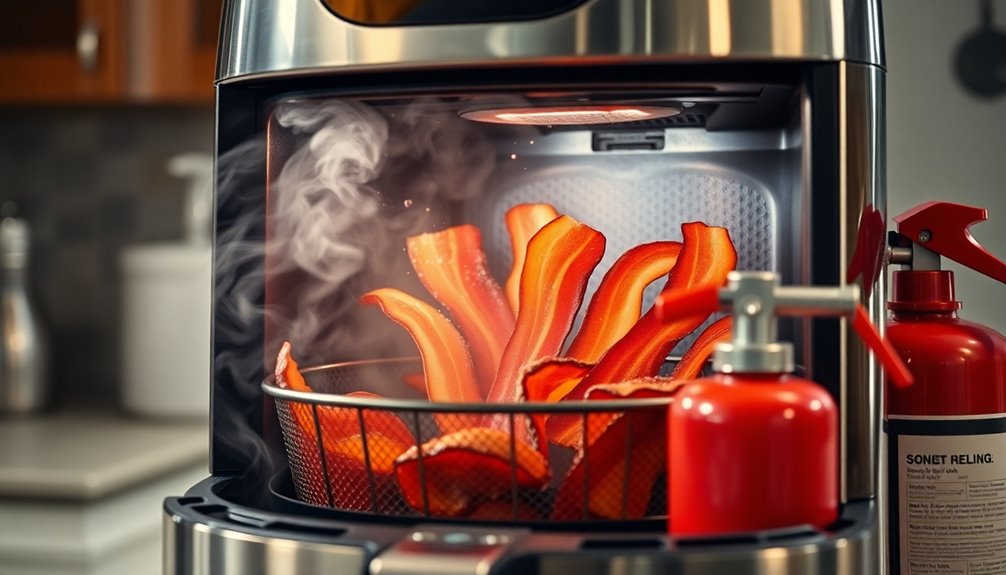
To keep your air fryer in top shape and guarantee safe cooking, it's essential to establish a regular maintenance routine.
Start by cleaning your air fryer after each use to prevent grease accumulation, which can damage components and cause smoke. Always check that the basket is free from leftover food particles and grease to minimize cross-contamination risks.
Follow the manufacturer's guidelines for cleaning procedures; improper cleaning can void warranties and affect performance.
While cooking, monitor your air fryer closely, especially with high-fat foods like bacon that produce significant grease. Regular maintenance can enhance the efficiency of the refrigeration cycle and prolong the lifespan of your appliances.
Finally, allow the air fryer to cool down before cleaning to avoid burns and ensure safe handling.
These maintenance and safety tips will help keep your appliance functioning well.
Flavor and Texture Comparison
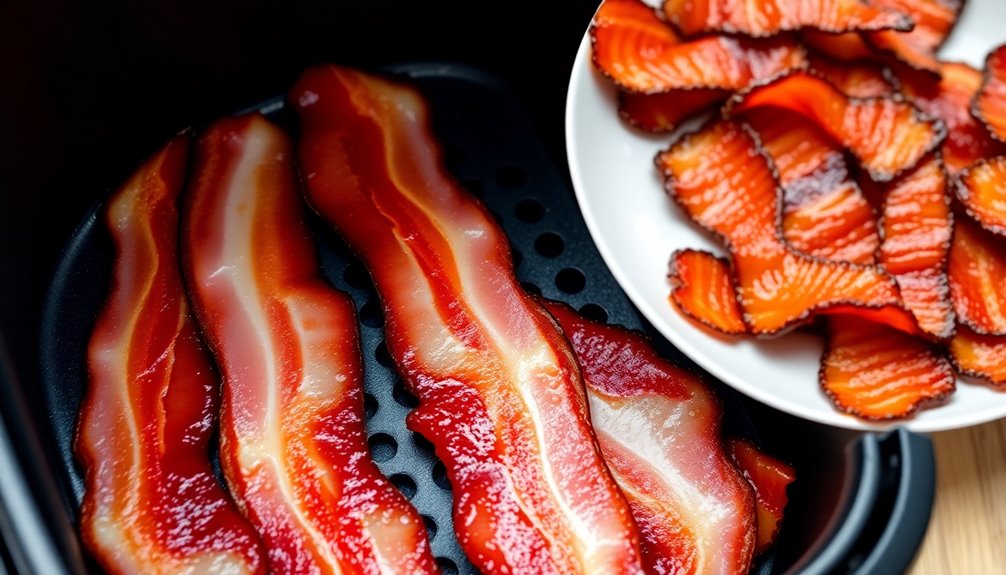
When you cook bacon in an air fryer, you might notice some uneven textures, with chewiness in certain spots and overcooked areas elsewhere.
In contrast, using a skillet or oven often gives you that consistent crispiness and a richer flavor profile.
Let's explore how these cooking methods impact both the texture and taste of your bacon.
Cooking Method Impact
While air fryers offer a quick and convenient method for cooking bacon, the impact on flavor and texture can be considerable. Consider these points:
- Uneven cooking results in some bacon strips overcooked and others chewy.
- High temperatures can render fat too quickly, creating excessive smoke.
- Air-fried bacon often lacks moisture, leading to a drier texture.
- Achieving the desired crispiness is harder compared to skillet or oven methods.
- The rich, smoky flavors from traditional cooking techniques are compromised.
When you choose air frying, you might sacrifice the robust flavor and satisfying texture that come from more traditional cooking methods. Opting for skillet or oven cooking can elevate your bacon experience considerably.
Texture Differences Observed
Although air fryers can deliver a quick cooking solution, the texture of bacon often suffers as a result.
When air frying bacon, you might notice significant texture differences; while the outside can achieve a crispiness, certain areas may end up chewy due to uneven cooking.
Traditional methods, like skillet frying or oven baking, provide consistent heat distribution, ensuring every strip is uniformly crispy.
Additionally, the high-fat content of bacon renders during cooking, leading to grease splatters in the air fryer that can compromise both texture and flavor.
In contrast, conventional techniques allow for better control, resulting in a more satisfying bacon experience.
Ultimately, if you value texture, sticking to traditional methods is the way to go. Furthermore, cooking in environments with poor indoor air quality can also exacerbate any unpleasant cooking smells, making the air fryer less desirable for bacon preparation.
Flavor Profiles Defined
Understanding the flavor profiles of bacon cooked in different methods highlights the impact of cooking technique on taste and texture.
When choosing how to cook your bacon, consider these key points:
- Air fryers can lead to uneven cooking.
- Skillet frying offers better heat control.
- Oven baking provides uniform texture and flavor.
- Direct cooking methods impart a smoky taste.
- Air-fried bacon often lacks rich, savory depth.
The cooking method greatly influences flavor and texture.
Traditional techniques like skillet frying or oven baking allow for ideal heat distribution, resulting in consistently crispy bacon.
In contrast, air frying may produce a chewy piece alongside an overcooked one, diminishing your overall flavor experience. Additionally, using methods like advanced filtration systems can help reduce any lingering odors from bacon cooking.
Frequently Asked Questions
Why Shouldn't You Do Bacon in the Air Fryer?
You shouldn't cook bacon in an air fryer because it can lead to uneven results. Some pieces might get crispy while others stay chewy.
The high fat content creates a lot of smoke, making your kitchen messy and causing unpleasant odors.
Plus, if you're cooking a large batch, you'll have to do it in multiple rounds, adding to your cleanup time.
Finally, grease splatters can create fire hazards, complicating the cooking process.
What 5 Foods Should You Not Put in an Air Fryer?
You might think your air fryer can handle anything, but some foods just don't belong in there.
Avoid wet-battered items like corn dogs; they won't crisp up and can mess things up.
Lightweight greens, like kale, get tossed around, cooking unevenly.
Don't heat liquids, either, as they create steam hazards.
Grains, especially pasta, need boiling water for proper cooking.
Finally, steer clear of certain cheeses that can melt and stick without a proper coating.
What Is Unsafe in an Air Fryer?
When using an air fryer, it's important to avoid certain foods for safety. High-fat items can produce excessive smoke and create fire hazards.
Additionally, raw meats like bacon can lead to cross-contamination if not properly cleaned afterward.
You'll also want to steer clear of foods that may not cook evenly, as they can harbor harmful bacteria if undercooked.
Always monitor your cooking to guarantee safety and quality in your meals.
Where Does the Grease Go When You Air Fry Bacon?
Did you know that bacon can render about 30% of its weight in grease while cooking?
When you air fry bacon, the grease drips down into the fryer basket, collecting at the bottom. This can lead to a buildup that creates smoke if it's not monitored.
You'll need to check and dispose of the grease after each batch to avoid any unpleasant odors or potential fire hazards.
Keep it clean for safer cooking!
Conclusion
So, before you toss that bacon into your air fryer, pause for a moment. Imagine the potential health risks lurking beneath the crispy surface. Consider the cross-contamination that could ruin your next meal. There are better, safer alternatives waiting to elevate your breakfast game. Will you take the plunge into the world of traditional cooking methods, or risk it all for a fleeting moment of convenience? The choice is yours—but tread carefully!
